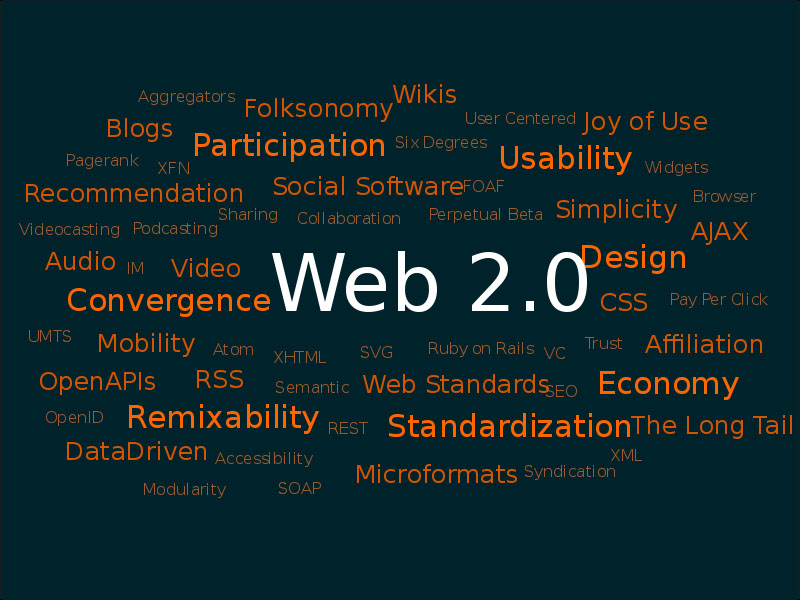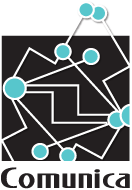| |
|
| The term social media refers to ‘a group of internet-based applications that build on the ideological and technological foundations of Web 2.0 (the new second generation platforms available on the internet) and that allow the creation and exchange of user-generated content’*.
Social media enable people/organisations to:
- connect and communicate with other people/organisations;
- collaborate with other people/organisations;
- create and exchange content; and
- identify, use, organise and re-use content.
|
 |
Social media take on many different forms, including: Internet forums; weblogs; social blogs; microblogging; wikis; podcasts; video and social bookmarking.
Download a helpful guide to social media links and resources for researchers produced by the Research Information Network.
There is growing interest in, and use of, social media tools and services to support and engage learners, and they are recognised as offering researchers huge opportunities to improve the way they work. Because they open up new forms of communication, dissemination and networking, the potential value of social media within the broader context of evidence-informed policy and practice is also now beginning to be explored. We have collected examples of the use of social media by different stakeholders, including its use to broker the gap between research, policy and practice, see below.
How are social media being used in teaching and learning?
There is growing interest in, and use of, social media to support and engage learners. Some examples taken from the recent review by Anderson (2007) include:
- Social bookmarking experiments: for example, Harvard University’s H2O project provides for shared playlists (shared lists of readings, blog postings, podcasts and other content), which can be tagged and subscribed to as RSS feeds
- In the UK, Warwick University has provided easy to use blogging facilities to allow staff and students to create their own personal pages. The intention is that the system will have a variety of education-related uses such as developing essay plans, creating photo galleries and recording personal development
- At the State University of New York, the Geneseo Collaborative Writing Project deploys wikis for students to work together to interpret texts, author articles and essays, share ideas, and improve their research and communication skills collectively
Other reviews of the potential impact of social software on education in the UK include Social Software and Learning (Owen et al., 2006)
How are social media being used by researchers?
Social media are recognised as offering researchers huge opportunities. They can enhance three core areas of practice: accessing, searching for and sifting information, communication and collaboration with others and building peer-to-peer networks.
A recently produced guide by the Research Information Network (Cain et al., 2011) includes a number of examples of the ways in which social media is used in research, based on interviews with researchers in a range of disciplines who are active users of social media.
A study conducted by the British Library (Halper, 2008) looked at websites to collect information about the use of social media by social science researchers. Some examples taken from this report include:
- Facebook and Myspace: Examples found of researchers using these to gather data and conduct online surveys
- Podcasts: Some research institutes (e.g. IPPR and the Centre for Market & Public Organisation) produce regular podcasts. Many Universities produce podcasts of undergraduate lectures. Intute produce podcasts of their events.
- Discussion forums: For example, the British Sociological Association, ESRC Society Today, the think-tank Demos, and others have discussion forums on their websites. Demos conducts research using online discussion forums, blogs, wikis and collaborative workspaces.
Anderson (2007) also reviewed examples of the use of social media in scholarly research and academic publishing. Some examples taken from this report include:
- Folksonomies: one example of their use in scientific research environments is the CombeChem work at Southampton University which involved the development of a formal ontology for laboratory work which was derived from a folksonomy based on established working practices within the laboratory.
- Blogging: examples of collective blogging include ScienceBlogs and RealClimate, in which working scientists communicate with each other and the public, as well as blog-like, peer-reviewed sites such as Nature Protocols. These tools provide considerable scope to widen the audience for scientific papers
- Developments in scientific data mash-ups and the use of Web Services to link together different collections of experimental data (Swan, 2006).
How are social media being used to link research, policy and practice?
Because they open up new forms of communication, dissemination and networking, the potential value of social media within the broader context of evidence informed policy and practice is also being recognised.
For example, the use of Twitter is becoming increasingly popular across all subject areas as professionals use it (a) to find and/or communicate information about issues they find interesting and (b) for professional networking. It represents a key example of social media being used to link research, policy and practice. Many networks, think tanks, academic journals, and so forth, are using Twitter. A few examples include:
- Ontario Institute for Studies in Education (OISE) of the University of Toronto (@OISENews)
- Cochrane Library (@CochraneLibrary)
- United Nations Educational, Scientific and Cultural Organization (UNESCO) (@unescoNOW)
- British Medical Journal (@bmj_latest)
- Institute for Public Policy Research (@IPPR)
To what extent are researchers making use of these tools to transform research collaboration and knowledge-sharing? What are people’s views on its use in academic research? Which strategies are most effective? What can we do to encourage greater uptake? And how especially do we encourage its use to bridge the gap between research, policy and practice? Addressing such questions is the focus of a new and exciting area of research.
 |
In 2010, Fundación Comunica, together with the Association for Progressive Communications (APC), launched the Impact 2.0 iGuide: New mechanisms for linking research and policy, a guide "designed to help researchers identify the right social media tools for establishing links with policymakers, for building their online presence and credibility and for effectively communicating their research." The research identified emerging good practices in this area. It focused on:
- How researchers can effectively and strategically use social media to better understand the policy context, e.g. to identify and understand the main policy actors, to identify key issues themes, and to recognise opportunities.
- How researchers can use social media tools to encourage discussion, debate and collaboration based on their research findings.
- How researchers can use social media tools to develop and maintain relations with policymakers and other important stakeholders.
|
| |
Links to other research on the use of social media are available in our Resources section. |
* Kaplan Andreas M., Haenlein Michael, (2010), Users of the world, unite! The challenges and opportunities of social media, Business Horizons, Vol. 53, Issue 1
|
|